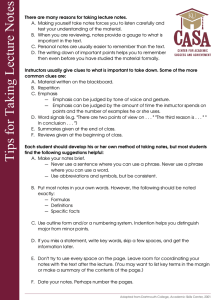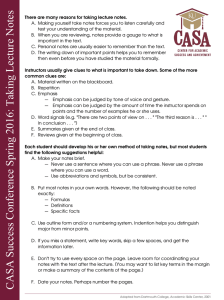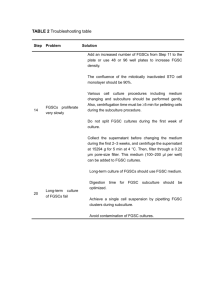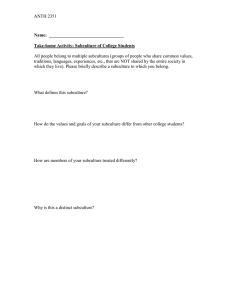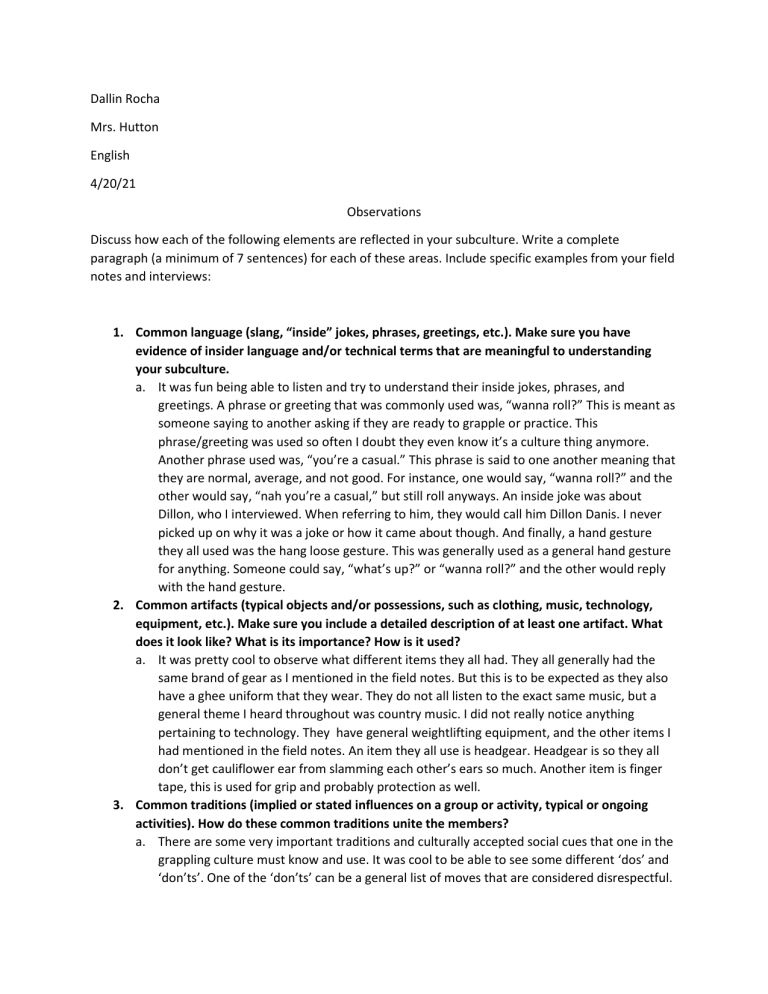
Dallin Rocha Mrs. Hutton English 4/20/21 Observations Discuss how each of the following elements are reflected in your subculture. Write a complete paragraph (a minimum of 7 sentences) for each of these areas. Include specific examples from your field notes and interviews: 1. Common language (slang, “inside” jokes, phrases, greetings, etc.). Make sure you have evidence of insider language and/or technical terms that are meaningful to understanding your subculture. a. It was fun being able to listen and try to understand their inside jokes, phrases, and greetings. A phrase or greeting that was commonly used was, “wanna roll?” This is meant as someone saying to another asking if they are ready to grapple or practice. This phrase/greeting was used so often I doubt they even know it’s a culture thing anymore. Another phrase used was, “you’re a casual.” This phrase is said to one another meaning that they are normal, average, and not good. For instance, one would say, “wanna roll?” and the other would say, “nah you’re a casual,” but still roll anyways. An inside joke was about Dillon, who I interviewed. When referring to him, they would call him Dillon Danis. I never picked up on why it was a joke or how it came about though. And finally, a hand gesture they all used was the hang loose gesture. This was generally used as a general hand gesture for anything. Someone could say, “what’s up?” or “wanna roll?” and the other would reply with the hand gesture. 2. Common artifacts (typical objects and/or possessions, such as clothing, music, technology, equipment, etc.). Make sure you include a detailed description of at least one artifact. What does it look like? What is its importance? How is it used? a. It was pretty cool to observe what different items they all had. They all generally had the same brand of gear as I mentioned in the field notes. But this is to be expected as they also have a ghee uniform that they wear. They do not all listen to the exact same music, but a general theme I heard throughout was country music. I did not really notice anything pertaining to technology. They have general weightlifting equipment, and the other items I had mentioned in the field notes. An item they all use is headgear. Headgear is so they all don’t get cauliflower ear from slamming each other’s ears so much. Another item is finger tape, this is used for grip and probably protection as well. 3. Common traditions (implied or stated influences on a group or activity, typical or ongoing activities). How do these common traditions unite the members? a. There are some very important traditions and culturally accepted social cues that one in the grappling culture must know and use. It was cool to be able to see some different ‘dos’ and ‘don’ts’. One of the ‘don’ts’ can be a general list of moves that are considered disrespectful. To be clear, disrespectful moves are considered ‘too far’ and not nice. They also this kind of air about them that is like a I-trust-that-you-won’t-break-the-unspoken-oath type of vibe. Some of these moves could be a spladle, which is when you bring the opponent’s ankles up to their ears (very painful). Another is a cross-face, when you ‘strike’ the opponents nose by moving your arm across their face really fast. Grapplers are not allowed to draw back and strike, so a disrespectful (and technically not illegal) move is not very considerate. A ‘do’ is to ‘dab (your opponent) up’. This is just sliding your hands together and ending with a fist bump. It is the nice thing to do and is basically to be expected. 4. Shared attitudes and ideas (about the group itself, about the group’s relationship to society in general, toward outsiders or new members). What are some of the shared attitudes and ideas? a. Some very common shared attitudes I observed were very strong and prominent in each person. They all think the same and, to be honest, look the same in a way. I am sure they would not agree, but different people from different sports all generally fit into a stereotype that is pretty accurate. The grapplers all fit under a wrestling category; generally shorter, very muscular, short haircut, and cauliflower ear sometimes. Compared to runners; generally lanky and lean, and muscularly defined legs. With their shared attitude and physical look, and same mindset they have a specific view of other people. They feel superior and brinksmanship-like. Most people cannot put you in a rear naked choke hold within seconds of a fight. This is an understandable, well deserved, and fitting attitude. 5. A sense of belonging (why do they belong? What benefits do they gain by membership?). a. As I have observed them, I have noticed that they all are very closely knit together. I mentioned in my field notes that they all seem to know each other very well. Literally no one was left out or at odds with one another. By being in this little subculture they gain a ‘family’ of people who beat each other up but still are the best of friends. I think this is a very strong characteristic of BJJ membership. It is tough to work out and practice in a way that is different from other sports. Being this way, it creates a different atmosphere compared to other sports. I am in a running subculture which could possibly be the farthest and yet the closest in differences and similarities. It was cool to observe the differences.
